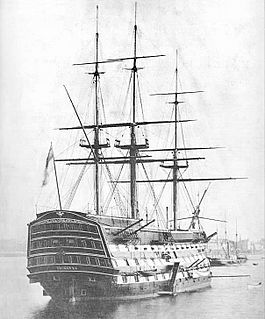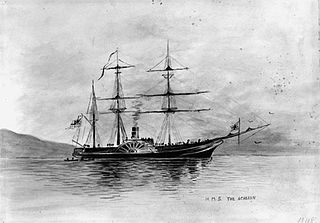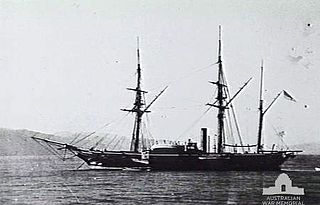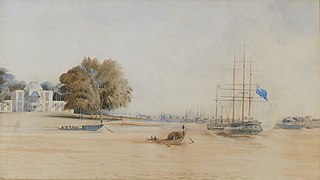
In the rating system of the British Royal Navy used to categorise sailing warships, a first rate was the designation for the largest ships of the line, equivalent to the 'super-dreadnought' of more recent times. Originating in the Jacobean era with the designation of Ships Royal capable of carrying at least 400 men, the size and establishment of first-rates evolved over the following 250 years to eventually denote ships of the line carrying at least 80 guns across three gundecks. By the end of the eighteenth century, a first-rate carried no fewer than 100 guns and more than 850 crew, and had a measurement (burthen) tonnage of some 2,000 tons.

HMS Orpheus was a Jason-class Royal Navy corvette that served as the flagship of the Australian squadron. Orpheus sank off the west coast of Auckland, New Zealand on 7 February 1863: 189 crew out of the ship's complement of 259 died in the disaster, making it the worst maritime tragedy to occur in New Zealand waters.

HMS Driver was a Driver-class wooden paddle sloop of the Royal Navy. She is credited with the first global circumnavigation by a steamship when she arrived back in England on 14 May 1847.

The Sail and Steam Navy List: All the Ships of the Royal Navy 1815–1889 by Rif Winfield and David Lyon is a historical reference work providing details of all recorded ships in commission or intended to serve in the Royal Navy from 1815 to 1889. Where available in Admiralty records, it gives the location of construction, dates of construction, principal dimensions and tonnage, armament, machinery and fate of every ship of the Royal Navy over the period.

HMS Acheron was a Hermes-class wooden paddle sloop of the Royal Navy. She was launched at Sheerness in 1838. Between 1848 and 1851 she made a coastal survey of New Zealand, the first such survey since Captain Cook. She was sold at Sydney in 1855.

HMS Niger was an 8-gun screw sloop launched on 18 November 1846 from Woolwich Dockyard. She had been intended as a sailing sloop but her design was lengthened to fit a steam engine, and she was fitted with screw propulsion at Deptford Dockyard in 1847-48 prior to completion. She was reclassified as a corvette in 1852.

HMS Harrier was a Royal Navy Cruizer-class screw sloop launched in 1854. She took part in the Crimean War, served on the Australia Station and took part in the New Zealand Wars. She was broken up in 1865

HMS Eclipse was a 4-gun Cormorant-class first class gunvessel launched in 1860 from the shipyard of J. Scott Russell & Co., Millwall. She served on the Australia Station, took part in the Second Taranaki War, including contributing men to a naval brigade which attacked the Maori stronghold at Gate Pā. The entire class were never satisfactory as gunvessels, partly due to their excessive draught, and Eclipse was broken up at Sheerness in 1867, only 7 years after her launch.

HMS Virago was a Royal Navy Driver-class wooden paddle sloop launched on 25 July 1842 from Chatham Dockyard.

HMS Torch was an Alert-class sloop of the Royal Navy, built at Sheerness Dockyard and launched in 1894. She served in Australia and New Zealand and was transferred to New Zealand as a training ship in 1917, being renamed HMS Firebrand at the same time. She was sold in 1920 and converted to a refrigerated ship with the new name Rama. She ran aground in the Chatham Islands in 1924 and was abandoned.

HMS Tauranga was a Pearl-class cruiser of the Royal Navy. The vessel was originally named Phoenix and built by J & G Thomson, Glasgow. She was launched on 28 October 1889. Renamed on 2 April 1890, as Tauranga as part of the Auxiliary Squadron of the Australia Station. She arrived in Sydney with the squadron on 5 September 1891. During the Samoan civil war in 1899, she took part in operations with HMS Porpoise and HMS Royalist. Spending between 1901 and 1903 in reserve at Sydney before being assigned to the New Zealand division of the Australia Station. She left the Australia Station on 14 December 1904. She was sold for £8500 in July 1906 to Thomas Ward for breaking up.
HMS Renard was a schooner of the Royal Navy, built by John Cuthbert, Millers Point, New South Wales and launched 16 January 1873.

The colonial service Defender-class torpedo boats were designed by Thornycroft & Company for the defence of New Zealand, built at Chiswick in 1883 and shipped to New Zealand. They were quickly obsolete and were left to deteriorate in situ. The remains of Defender are preserved at the Lyttelton Torpedo Boat Museum.

HMS Taiaroa was a colonial service Defender-class torpedo boat designed by Thornycroft & Company for the defence of New Zealand. She was named after Te Matenga Taiaroa, a 19th-century Māori chief of the Ngāi Tahu iwi. She was built at Chiswick in 1883 and shipped to New Zealand, where she was assigned to the defence of Port Chalmers.

HMS Waitemata was a colonial service Defender-class torpedo boat designed by Thornycroft & Company for the defence of New Zealand, built at Chiswick in 1883 and shipped to New Zealand.

HMS Imogene was a Conway-class sixth rate of the Royal Navy, built by Pembroke Dockyard and launched on 24 June 1831. She served in the East Indies, China and South America, but was accidentally burnt while out of commission on 27 September 1840.

HMS Galatea was a Jason-class 26-gun, sixth-rate, wooden screw frigate in the Royal Navy, launched in 1859 and broken up 1883.

HMS Alligator was a 28-gun Atholl-class sixth rate of the Royal Navy. She was launched at Cochin, British India on 29 March 1821.

HMS Calliope was a 28-gun sixth rate launched in October 1837 and broken up in November 1883.

HMS Dido was an 18-gun Daphne-class corvette built for the Royal Navy during the 1830s.


















